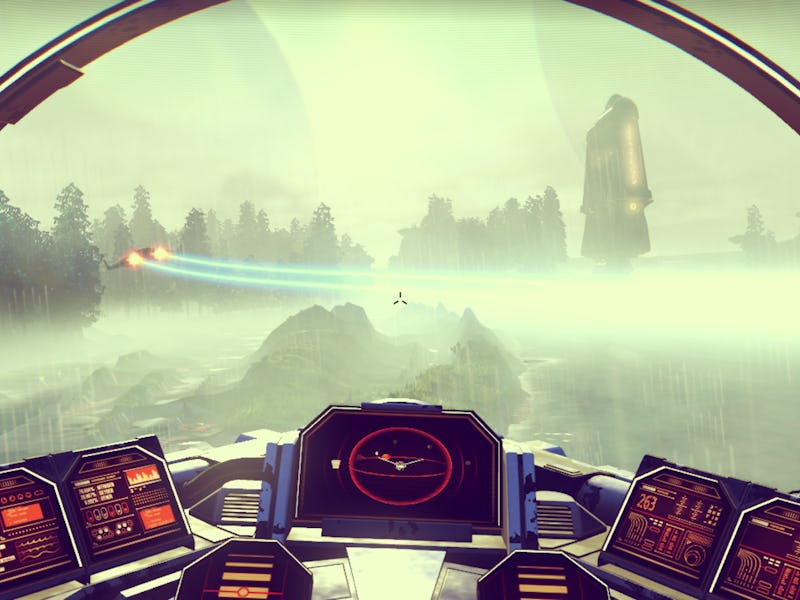How to Manage and Spend Resources Like a Smarty in 'No Man's Sky'
Don't get your rocks off just yet. Here's how to be smart with your inventory.

The sandbox exploration game to end all sandbox exploration games is here: No Man’s Sky. As a nomad space traveler in Hello Games’s wide-open universe, you’re challenged to survive the elements by mining resources while evading the wrath of fly-over drones known as Sentinels. It’s a big, dangerous place, and if you have to survive, you gotta be smart.
Mining and collecting resources is one of the most crucial aspects of No Man’s Sky. Having the right stuff allows you to recharge your exosuit (which protects you from hazardous environments), to refuel your starship, and to upgrade your mining tool into a defensive weapon against rabid wildlife and armed drones. But not all tools recharge with the same minerals, and you only have a limited number of free slots to store resources. So just how does one carefully — and cleverly — stock and refuel?
First, you should know what your elements are.
Know Your Element Types
In No Man’s Sky resources are officially labeled into different types: “Isotope,” “Silicate,” or “Oxide,” and others. But more simply, they’re identified by colors like red, blue, yellow, etc. This makes identifying them whilst exploring much easier.
Here’s a quick list of the element types, their colors, and what they’re used for:
Oxide: Yellow minerals you’ll often use to recharge and rebuild your exosuit (which shields you from hazardous environments) as well as other tech. If you’re low on oxide minerals, you can cheat a little by hiding in your ship which re-shields your exosuit — but that only delays the inevitability of needing to go and collect more.
Silicate: Blue minerals that help you craft tech that improve your tools. If you want to run faster or have a stronger suit, this is the good stuff to get.
Isotope: Red minerals that refuel your ship, your weapons, your life-support (the battery that powers your exosuit) and other tools. Your ship’s components require different isotopes: Flying requires Thamium9, while launching to get in the air in the first place requires another, Plutonium. Based on my experience, I’ve had trouble stocking up on Plutonium while Thamium9 is a little easier to get as space it lousy with it.
Neutral: Green minerals that are typically used in conjunction with other minerals to craft other kinds of upgrades, similar to Silicate.
Precious: Purple minerals that, at least so far in the game, don’t have a specific purpose yet. Extremely rare to find, these fetch a pretty penny on the galactic market. Keep some just in case: You can sell them for thousands later.
Some resources in No Man’s Sky are more plentiful than others. The more common the resource, the cheaper they are to sell on the market, but just because they’re almost worthless doesn’t mean they’re useless.
Collect and Spend Common Minerals as Much as Possible
Carbon (red isotopes), Iron (yellow oxides), and to an extent, Heridium (blue silicates) are the most abundant elements you can find. Carbon and Iron are scattered everywhere; Heridium rock formations are not, but when you do find them, you’ll net Heridium by the truckload.
It’s crucial to keep these common minerals in regular number. Spend them as much as you collect them. Carbon can be used to keep your Mining Beam (mining laser) or Boltcaster (your first gun) charged as well as your exosuit’s life-support, which keeps you alive. Meanwhile, Iron is used to keep your exosuit’s hazard protection shields up, which protects you from toxic environments.
You’re of course free to use more powerful and rare minerals like Thamium9 and Chrysonite (a rare Silicate) to power up the aforementioned tools — but why do that when you can charge them just as much with far less valuable minerals?
Keep Stock of Thamium9 and Plutonium
Two other minerals you should keep handy are Thamium9 and Plutonium, both red Isotopes. As mentioned before, these two power different aspects of your ship but are much harder to obtain than Carbon.
Thamium9 is found in abundance on asteroids in space, but on the ground you’ll find them in plants and other vegetation. Plutonium is obtained by mining sharp red crystals deep inside caves. Both require effort and time that, in more situations than you think, you may not have a lot of. So always spare room in your Inventory for these exact two resources.
Don’t Sell Everything All at Once
When unloading inventory at stations or planetary outposts, it’s common sense to sell what you don’t need for a payday. But don’t sell everything: Not only because you should keep some in reserve, like I’ve said a dozen times already, but because some “common” elements may actually be rare and valuable in other systems. When shopping, take note of the percentage markups; selling may actually cost you than if you were to keep it and sell it somewhere else.
It’s not limited to elements either. Sometimes you’ll come across particular commodities related to specific alien species. These may not be valuable in the star system you’re in, but they may be priceless elsewhere.
So to recap: Keep and spend so-called “worthless” or common elements regularly, always have a stock of Plutonium and Thamium9 to maintain your ship, and don’t just sell everything at stations. No Man’s Sky is a vast universe. Danger lurks and you should always be prepared.